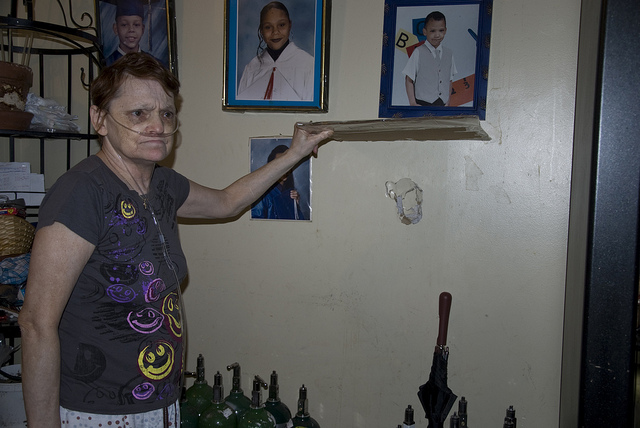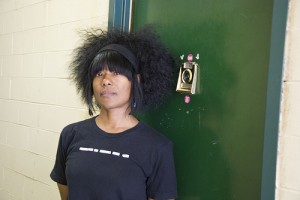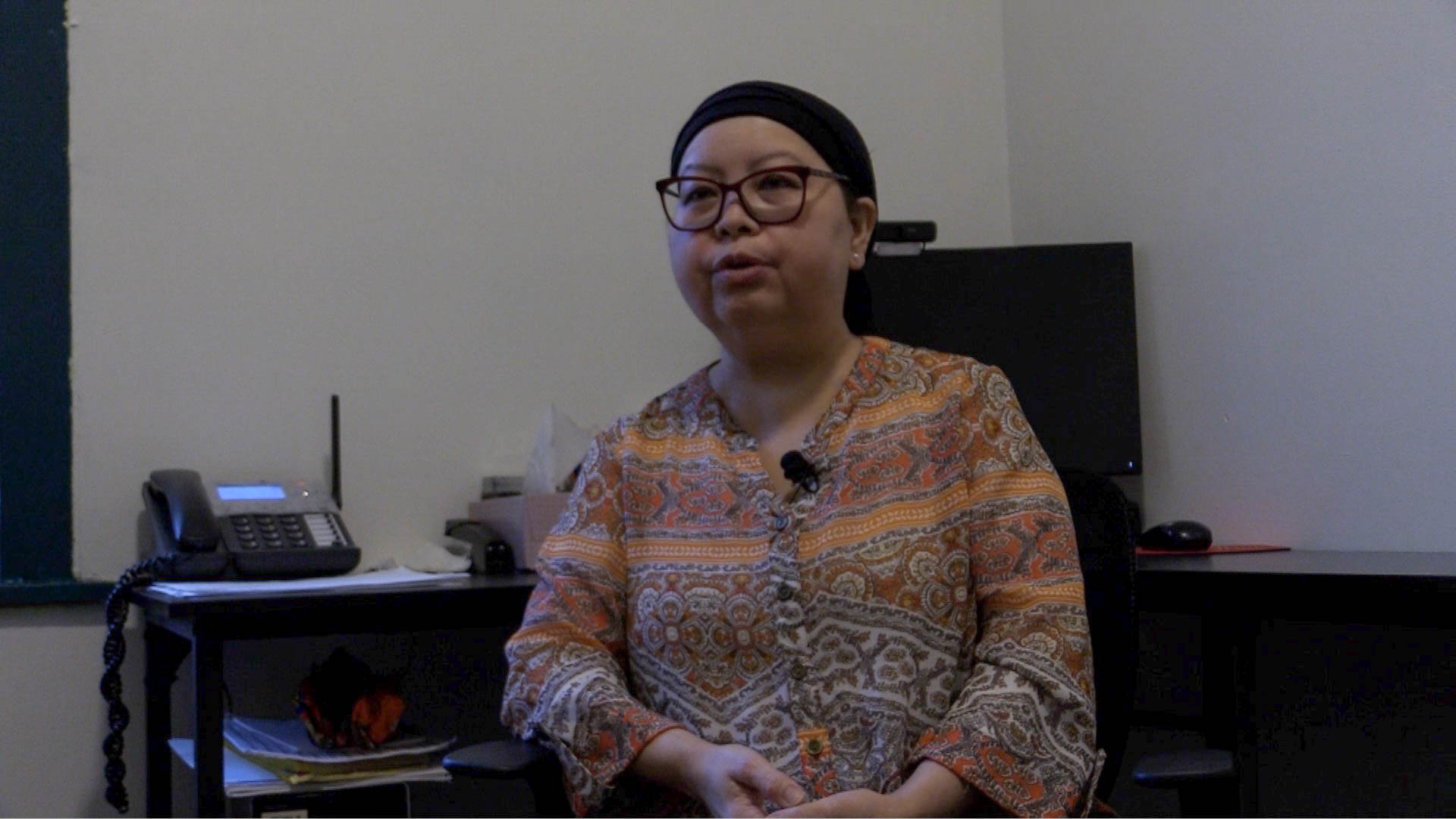
Ruth Christie, an LES II resident, lifts up a frame she hung to hide a hole in her wall. She said her home is making her sick. Photo by Rachel Wise
Betty Buck was sleeping in her apartment in Lillian Wald Houses when she heard a loud crash from the kitchen.
“It was the middle of the night and suddenly I was wide awake because I heard a huge noise in the other room,” Buck recalled. “It was late so I was nervous.”
She walked cautiously out of the bedroom and immediately saw the source of the noise – her cabinet unit had detached from the wall and crashed onto her stovetop.
“The last thing I expected was to see those huge cabinets come off of the wall,” Buck said. “How could that even happen?”
Buck, a tenant for more than 40 years in Wald Houses on Avenue D, quickly reported the incident to New York City Housing Authority (NYCHA) and a maintenance worker showed up just days later but did little.. The worker simply moved the cabinet unit from the top of the stove to the floor directly beside it. The cabinet unit now crowds Buck’s small kitchen area and prevents her from using the stove. The wall from which it fell remains bare; on the white plaster surface covered with holes, she uses a thick black marker to tally the months that have passed without repair.
The Housing Authority says it will be back to repair the damage in June of 2012.
More on this project in the New York Daily News, which includes video produced by Reinhard Cate
Residents say serious repair issues within NYCHA developments are spiraling out of control as buildings age and funding dwindles. Countless public housing tenants, like Buck, have come to expect two-year delays on maintenance requests.
Meanwhile, residents and health experts say the failure to repair serious problems – like water leaks that often lead to mold – are making some tenants sick.
Ruth Christie believes her home is killing her. A longtime resident of East Village public housing, Christie says she will die prematurely if she cannot be relocated. “(The doctor) told my manager that if I don’t move, this building’s going to kill me,” she said. Christie, 59, had emphysema and asthma prior to moving into her Lower East Side II apartment in 2004, and said her condition has worsened in recent years because of poor housing conditions. “I wasn’t on oxygen until I moved here,” she said. “Since (2007), I been getting worse.”
Christie is not the only tenant in the New York City Housing Authority public housing developments to blame poor housing conditions for difficulties with breathing and asthma. In every public housing development in the East Village — except LES III, the newest development — residents specifically pinpointed mold for respiratory problems, which raises concern about whether the state of disrepair in these houses poses a serious health issue.
NYCHA owns and maintains 21 developments in New York City. In the East Village, there are seven: First Houses, Bracetti Plaza, Campos Plaza, LES II, LES III, Riis Houses and Wald Houses. Public housing is largely populated by black and Hispanic families — and, according to both the New York City Department of Health and medical experts at Columbia University, both ethnic groups have a disproportionately high prevalence of asthma.
Toni Footman, 42, has lived in a large three-bedroom apartment in the Lillian Wald Houses with her sons for the past eight years. One of her children has been diagnosed with asthma, and Footman described some worrisome new developments with her own health.
“Lately my chest been really bothering me,” she said. “I’m really a healthy person. I’m a vegan; I work out. And it’s only when I’m inside of my home that I feel like I can’t breathe.”
Worried she might be developing asthma, Footman said she has visited the doctor multiple times. Her breathing problems persist, but a diagnosis has yet to be made.
Residents say a new centralized system designed to streamline repair issues has only made matters worse.
“When people say they have to wait two years for a leak to be fixed, and that’s in their kitchen or bathroom, that really is a problem,” said Assemblyman Vito Lopez.
To improve service delivery to residents, NYCHA introduced the Customer Contact Center, a centralized maintenance request system. Tenants with repair issues are now instructed to file maintenance requests with the CCC, rather than reporting to decentralized housing assistants. Initiated in 2005 and rolled out borough by borough until 2007, the CCC serves each of NYCHA’s 403,665 authorized residents who occupy 178,407 apartments.
Although the new system was created to decrease maintenance delays, tenants agree that repairs now take longer than ever before. According to community leaders, the level of resident dissatisfaction has risen in recent months.
“People are really getting upset,” said Assemblyman Lopez. “In the last three or four months, people have been calling local legislators and pushing me to speak. They’re really scared.”
According to General Manager Kelly, standardized data entry was a major reason for the creation of the CCC. The decentralized system, he said, did not provide critical measurements for service improvement.
“The CCC allows us to use data for intelligent reporting, so that we can continue to improve the system,” Kelly said. “For the first time, we know, authority-wide, what our needs are.”
At a recent public hearing, NYCHA General Manager Michael P. Kelly was asked to provide information on work order backlog. He was unable to do so. “We tried to pull [the information] together for this hearing,” Kelly said, “But we don’t have it for you today.”
Kelly recognized the gravity of the maintenance issue and sympathized with residents.
“Clearly it’s a situation that we are not happy about,” Kelly said. “No one wants to resolve this problem more than NYCHA.”
Unfortunately for Nilda Gomez, Kelly’s sympathy can’t solve the repair problems in her Jacob Riis apartment.
The most prominent features of Gomez’s bedroom are the disconnected pipes, jutting diagonally across the wall beside her bed. Contractors ripped the pipes out of the wall during the process of repairing Gomez’s heating system.
A dirty bathroom towel now haphazardly covers the end of the pipe that is meant be attached to the ceiling. According to Gomez, rather than removing the broken pipes, workers said that the towel would suffice.
“This just looks bad now,” said Gomez, “but when the heat comes on, hot water and steam will be coming out.”
The pipes weren’t the only casualties of the maintenance visit.
Gomez is also dealing with major ceiling leaks. Dressers, chairs and ironing boards are piled on top of one another in a heap in the middle of the living room.
“We have to leave everything in the center of the room because of the ceiling leaks,” Gomez said.
While the furniture may be safe from dripping water in the living room, Gomez isn’t so lucky herself. She is often awakened on rainy nights, her sheets and clothing wet because of leaks in her bedroom ceiling. Water also comes in through the bathroom and kitchen ceilings.
Like many tenants, Gomez is confused by NYCHA’s maintenance system.
“If the workers came to repair the pipes, why can’t they do the lock, ceilings and doors while they’re here?” she said. “It doesn’t make sense.”
Consolidating these tasks into one visit would appear to be the most efficient option. But according to Gloria Finkelman, NYCHA Deputy Manager of Operations, the division of labor is necessary. “We’re a union shop and we’re glad to be a union shop,” Finkelman said at a recent public hearing. “Certain union members have certain job descriptions that don’t allow them to do other union work.”
Iris Betancourt, a tenant in Lillian Wald, was appalled but not surprised by the condition of Gomez’s apartment. “I’ve seen this before. Take them to court,” Betancourt advised. “Or else nothing will get done.”
Like Betancourt, many tenants consider legal action to be the only solution when it comes
Footman continued to call the CCC and received several separate repair dates, all between 2012 and 2013. She decided to fight back and brought NYCHA to court on September 14th, demanding action.
Following an inspection, the court ruled in Footman’s favor. Judge Sheldon J. Halprin ordered NYCHA to exterminate for roaches within 30 days, plaster and paint the kitchen ceiling, east wall, and bathroom walls and ceilings, and paint the north wall and closet. Although the ruling seemed like a victory, Footman has yet to see results.
“The only thing they did so far was to come back and look, again,” she said. “Nothing was touched, nothing was done at all.”
Three days after the court ruling, a NYCHA inspector came to assess the condition of Footman’s apartment. According to Footman, the inspector recorded the damages and instructed her to call the emergency number again and put in tickets for each maintenance request.
“I was like, ‘I just did that, and I went to court.’ Why do I have to keep putting tickets in?” Footman said. “Nothing’s going to get done.”
According to NYCHA officials, the backlog of repairs is a result of insufficient funding rather than poor management and flawed systems. Scheduling availability for maintenance requests is based on staffing capacity, and lack of funding has made it difficult to find solutions.
“Given the severe budget deficit of recent years, between 2000 and 2009, our operations lost 1,540 employees,” General Manager Kelly said. “Currently, NYCHA only has $1.5 billion to address such repairs.”
Still, Huff believes there must be a middle ground. Residents must respect and care for the aging buildings, she said, but NYCHA must take responsibility for making desperately needed repairs in a timely manner. “I don’t want to live like this,” she said. “It’s not my fault.”
According to a recent study published in the Journal of Urban Health, frequent asthma attacks may be more common in housing that is old or in a state of disrepair. Common symptoms of deteriorating housing are “water leaks, holes that pests can pass through, poor ventilation, and peeling paint.” Water leaks are considered a significant problem because they can lead to holes and mold growth in homes.
Residents from every apartment visited cited some or all of these symptoms as problems NYCHA failed to repair. The most apparent problem was mold growth from water leaks, and it was most severe in Campos, Bracetti and First Houses. Though NYCHA does not qualify mold as an emergency that warrants immediate attention, there is reason to consider it a serious health concern.
According to the New York City Department of Health and Mental Hygiene, mold exposure “may cause or worsen asthma symptoms, hay fever, or other allergies.” But in addition to exacerbating asthma, it is possible that mold may cause the disease, according to Dr. Matthew Perzanowski, an associate professor of environmental science at Columbia University. “What’s been shown mostly in European studies is that children who grow up in damp homes…are more likely to develop asthma.”
In Campos Plaza, 12-year-old asthmatic, Angela Nicholson, said she couldn’t breathe in her bathroom when mold is present. Nicholson, who has lived with her aunt for the past six years, was diagnosed with asthma as a baby. Her asthma has worsened since this September, and she said it is most often exacerbated in the bathroom when she as at home. But, there is no way to ventilate the humid room because the only source of air circulation doesn’t work.
“Sometimes the vent smells a little nasty and it smells like mildew,” Nicholson said.
Nancy, a resident at Bracetti Plaza also complained about her inoperable bathroom vent. “If you put your hand there, you don’t feel a thing,” she said about the stagnant airflow. “So, that’s what causes the mold.”
Many East Village NYCHA housing residents blamed leaks from upstairs neighbors’ bathrooms as the reason for leaks and mold growth in their own apartments. According to the Department of Health, a persistent mold presence signifies an underlying problem, such as a water leak. To completely stop growth, the water problems must be fixed. Due to lack of staff and funding, however, NYCHA has been unable to make the needed repairs. Instead, if a contractor is available to come, the answer is to camouflage the problem.
Nancy, who declined to give her last name out of fear of repercussions from the housing authority, said she had already filed several requests for mold removal with NYCHA’s Customer Contact Center, but was unsatisfied with their temporary fix. “I had a problem with the (mold), a lot of mold,” she said, “and they kept repainting and repainting and repainting.”
This type of solution extends thoughout all developments, including LES II, where residents said it takes only three to six months for mold to grow back. In the past, Christie was told she would have to wait up to two years for NYCHA contractors to come to her apartment for repairs—and even then the solutions they offered were only superficial.
At one point, she had so much mold growing in her bathroom that the entire ceiling was black. Workers tore down the walls for emergency cleanup, but only painted over the mold on the ceiling.
“The mold is gonna still be there,” she said. “It’s just paint over it, so it’s coming back in my bathroom.”
In Wald, Footman has one child who is asthmatic, and another may also be at risk of developing the disease. Of the two sons currently living with her, the elder, William, 16, has been diagnosed with asthma. She said he recently started to complain about difficulty breathing and she believed his problems could be related to the state of disrepair in her home.
“I have damage to my bathroom’s walls; I have leakage; I have mold growing,” Footman said.
Footman’s younger son, Kevin, who does not have asthma, has had severe allergic reactions to allergens in the home. “(My) little one is nine, and he’s been having more breakouts because the mold is in the bathroom,” she said. “He’s inhaling that. He’s been scratching; his fingers all broke out.”
Another reason why asthma is so prevalent in children who live in public housing is because of exposure to pest allergens, said Dr. Marc Wilkenfeld, a board certified physician specializing in occupational and environmental medicine at Gouverneur’s Hospital in New York City.
“The same way you can be allergic to cats, you can be allergic to cockroaches,” Wilkenfeld said. Cockroach allergies cause the lungs to swell and close up; “If you have asthma, your allergy is going to make it a lot worse.”
Citing multiple safety code violations, Footman filed a lawsuit against NYCHA in late August of this year. On Sept. 14, New York City Housing Court Judge Sheldon J. Halprin ordered NYCHA to fulfill Footman’s work order — exterminate roaches, fix leaks, plaster and paint walls damaged by leaks — within 30 days. As of late November, Footman reported that none of the court-ordered repairs were made.
Christie also took NYCHA to court in September for failing to make repairs in her LES II home. Problems with doors, cabinets and walls existed even before she ever set foot into the apartment, neighbors said. Christie appealed to both building managers and called the NYCHA hotline to submit requests for repairs. With a letter of support from her doctor, Christie applied to transfer out of the building because of her various health concerns, but said NYCHA denied her.
The letter outlines Christies sensitivity to allergens caused by garbage, gnats, grass and mold. “The smell of the garbage and…when they cut the grass is so problematic to her breathing,” a doctor at Community Healthcare Network’s Downtown Health Center wrote. “When the sewer system backs up, knats appear all over the house…Her current living conditions are a problem and she urgently needs to move.”
Christie won her court case and the judge ordered the authority to make repairs. After years of waiting, NYCHA finally sent contractors to plaster holes in the walls; however, Christie was told she would still have to wait until 2012 new doors and cabinets.
After applying for a transfer two more times, Christie was finally approved. She has yet to receive word from NYCHA about when and where she will be relocated.
As part of a three-month investigation, the Local East Village requested a series of documents under the Freedom of Information Law from NYCHA. The authority responded that it had 30,000 to 35,000 documents that might be responsive to a request for copies of tests, reports or other statistics involving health concerns related to housing conditions. However, the authority has yet to make the documents available for inspection.
The LEV also made numerous attempts to speak with the New York City Health Department on how problems — such as mold, poor air quality and allergens — might affect the overall respiratory health of residents, but was declined an interview every time. According to a spokeswoman with the department, “There is no one available for an interview on this.”



Comments
I grew up many years ago living in the Lillian Wald Houses. In the 50’s and 60’s if there were repairs to be made they were accomplished pretty quick. The neighborhood was racially balanced and there was harmony. It saddens me deeply to see that this is how the city treats the people in its city projects and I believe that something should be done about this in the federal sense. I miss my old home and my memories are
awesome. I would be afraid to revisit and see such horrors.
How can anyone allow such inhuman conditions to exist in places where children reside. We as respectable humans have to do more than just pray. God bless all of you, and thank you for allowing my comments.